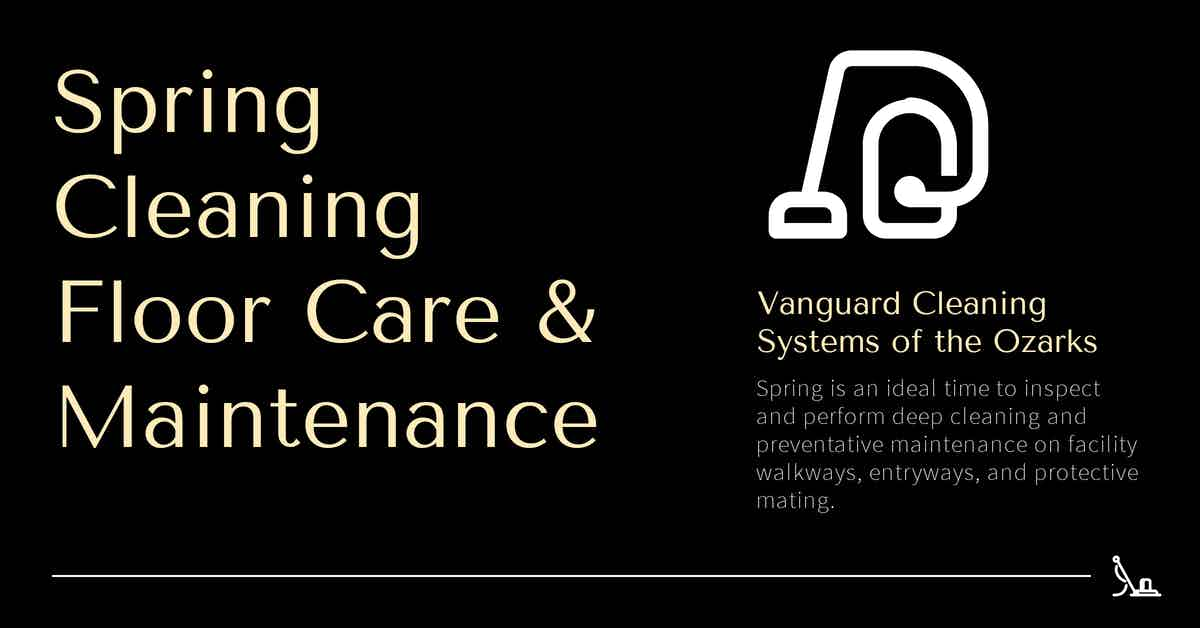Spring is an ideal time to inspect and perform deep cleaning and preventative maintenance on facility walkways, entryways, and protective matting.

Finish Spring Cleaning Strong With Facility Floor Care and Maintenance
Our previous article discussed the prerequisites for starting a comprehensive facility spring cleaning program that promoted building occupants' mental and physical health by removing clutter from offices, especially on floors and desks.
Clutter removal allows for unrestricted access to facility floors, which have likely taken a beating during the winter and are due for comprehensive maintenance and deep cleaning.
Deep cleaning and floor maintenance allow for the removal of soil, oils, deicing residue, chemicals, tar, gum, and dangerous bacteria that negatively impact the health of facility occupants and floor appearance and longevity.
Before beginning large-scale floor care and maintenance, it is important to assess current conditions, product and technique suitability, and potential hazards to facility occupants and guests.
What's On Your Floor May Hurt You
Floorcare during the winter months in cold, rainy, or snow-covered areas is challenging to the point where, in many cases, floor cleaning during that time period is considered a stop-gap between the dryer months when deeper cleaning can occur.
The issue is derived from the constant flow of moisture, mud, and deicing chemicals transferred into the building on the bottom of visitors' shoes.
Unfortunately, that isn't the only thing carried in on the bottom of our shoes.
A study conducted by Dr. Charles Gerba of the University of Arizona found that the presence of fecal matter on the bottom of occupant shoes--originating from either restroom floors or outdoors--was a constant threat to occupant health and facility hygiene.
According to an article published by USA Today regarding Dr. Gerba's findings;
[...] 10 people wore brand-new shoes for two weeks before their kicks were sampled for bacteria.
The outside of the shoes averaged 421,000 units of bacteria, compared with 2,887 on the inside.
And fecal bacteria appeared on 96% of the shoes.
That fecal bacteria indicates frequent contact with fecal material, which most likely originates from floors in public restrooms or contact with animal fecal material outdoors.
And here's the, ahem, kicker: The transfer rate of bacteria from shoes to clean tiles was 90% to 99%.
Bacteria found on the footwear included E. coli, a source of urinary tract infections and diarrhea, as well as other bacteria causing pneumonia (Klebsiella pneumonia) and respiratory tract infections (Serratia ficaria).
Leave your shoes at the door: Science says they're covered in poop and could make you sick
Additional bacteria commonly found on floors in public facilities include:
- Pseudomonas.
- Bartonella Henselae.
- Micrococcus.
- Chlamydophila Psittaci.
- Bacillus.
- Rickettsia Rickettsii.
- Staphylococcus, and;
- Capnocytophaga Canimorsus.
While the presence of the bacteria on the floor may seem to be a minimized hazard in most cases, data from a study in several Cleavland-area hospitals shows that the germs can be easily transferred to higher surfaces and occupant's hands.
According to Infection Control Today;
[...] researchers cultured 318 floor sites from 159 patient rooms (two sites per room) in five Cleveland-area hospitals.
The researchers found that floors in patient rooms were often contaminated with Methicillin-resistant Staphylococcus aureus (MRSA), VRE, and C. difficile, with C. difficile being the most frequently recovered pathogen found in both CDI isolation rooms and non-CDI rooms.
Of 100 occupied rooms surveyed, 41 percent had one or more high-touch objects in contact with the floor.
These included personal items, medical devices, and supplies. MRSA, VRE and C. difficile were recovered from 6 (18 percent), 2 (6 percent), and 1 (3 percent), respectively of bare or gloved hands that handled the items.
The reason cited by the article for the ready transmission of such deadly bacteria was disturbing, to say the least;
Although healthcare facility floors are often heavily contaminated, limited attention has been paid to disinfection of floors because they are not frequently touched.
Dirt Damages Facility Flooring
In addition to the dangers posed by fecal matter and bacteria tracked into facilities on the bottom of occupant shoes, soil brought in from outdoors poses a serious challenge to the appearance and longevity of facility flooring.
Soil is often gritty and acts like sandpaper on floors and carpets, dulling appearances and cutting against fibers resulting in thinning--an issue that is easily accelerated on improperly maintained surfaces.
An additional challenge derived from improper floor care and maintenance is the buildup of cleaning residue, which can result in rapid re-soiling and severely impact the surface's lifespan.
Recommended Floor Care Cleaning Products and Practices
Picking the wrong product or method to deep clean carpets and floors can result in significant damage to the surface and extremely high repair costs.
Other challenges posed by low-quality floor care practices and products include:
- Providing reservoirs for microbes.
- Promoting slips, trips, and falls, and;
- Exposing occupants to environmental toxins.
To combat these issues:
- Assess the chemical makeup of the floor cleaning, disinfection, deep cleaning, and polishing products being used for known hazards to facility occupants, especially respiratory, reproductive, and endocrine damage.
- Choose safer products documented and verified by the Environmental Working Group (EWG).
- Deep clean, strip and wax, and polish floors after hours to minimize occupant slip and fall risk and chemical exposure.
- Use fast-drying products or increase ventilation to prevent reservoirs from forming.
- Establish physical barriers to prevent foot traffic that can more quickly transfer germs and re-soil surfaces, and;
- Communicate routine cleaning, deep cleaning, and annual floor maintenance schedules, products used, and potential hazards to facility management and occupants.
Spring Cleaning Floor Matting
Floor, walkway, and entryway matting are commonly used to absorb moisture, collect dirt and bacteria, prevent slips and falls, and protect hard floors and carpets from wear and tear.
They are also routinely missed during the routine cleaning and maintenance, especially during the winter, and should be subjected to inspection, replacement, and thorough maintenance as part of a comprehensive spring cleaning floor care plan.
While the mats are removed for cleaning and inspection, examine the area beneath them for grime buildup and damage, especially in doorways or doorframes, and thoroughly clean the area.
Mats can typically be deep cleaned using a carpet extraction method, but it is best to consult any service guides or the manufacturer for best practices, especially with large, high-performance entry mats.
References & Resources
- What Types of Bacteria Are Lingering On Your Floor?
- Soil's Damage On Floors And Carpets
- Cleaning and disinfecting environmental surfaces in health care: Toward an integrated framework for infection and occupational illness prevention
- Floor Cleaning Procedures For Slip, Trip, And Fall Prevention
- Floor Mats Need Spring Cleaning, Too
Takeaway
Spring is the perfect time for many areas of the country to deep clean their carpets, hard floors, and walkway matting.
It's also the ideal time to assess and update routine floor care and maintenance products and practices to ensure the highest standards of cleanliness and occupant safety.
Outsourcing your organization's floor care and maintenance requirements to an experienced provider is a proven method for onboarding vital services without significantly increasing costs or management overhead.
Contact us today and discover why Vanguard Cleaning Systems® is the Standard of Clean® for businesses throughout Northwest Arkansas, Missouri, and Oklahoma.
In Oklahoma, dial 918-960-4450
In Arkansas, dial 479-717-2410
In Missouri, dial 417-812-9777

